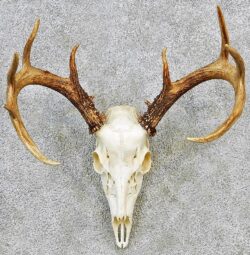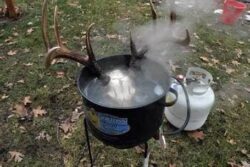Once the great antlered bull or buck is down, how can you clean and protect the antlers and skull for mounting? If too much organic matter is left in place, the place will become stunk up with rotting tissue and organs. Late Fall also means it is often too cold for insects and bugs to do their work. The outcome can be a smelly and unhealthy disaster.
CWD, Chronic Wasting Disease, adds another problem. This disease infects all deer and antlered big game critters. The disease seems to have begun on Game Farms. When the critters escaped, or infected carcasses were dumped in nature, the disease spread. Chances of tagging an infected critter are better than anyone would want to admit.
So far, consumption of infected meat does not infect consumers but if the free test from the state’s DNR or FWP tests positive, they say don’t eat it. There can also be other diseases spread from deer such as rabies, Lyme’s disease, and contamination from poor handling and care. Remember that wild game is not tested by the FDA or food quality agencies. Wild game is also not available to be sold to restaurants or grocers. What they call “Wild Game” is bought from the game farms where it is raised as livestock.
Rabies and CWD infect the brains of their hosts. This means that handling the head and shoulder mount of your trophy can infect anyone that encounters it. Rubber gloves are a good place to begin when handling and dressing your tagged critter. The brain, eyes, spinal fluid, lymph nodes in the head and neck are the prime locations of potential disease. The deer ticks on the hide are also a threat for the spread of Lyme’s disease.
Take some precautions before you deal with your trophy. At the very least, wrap it in plastic or multilayered bags. The whole head and rack can be frozen in a freezer or outside in the cold. Just place it where mice and pets can’t get to it. Drop it off at the taxidermist asap.
In some areas, the law may not allow transport of skulled trophies due to potential infection risk. If this is the case in your hunting area, have what you need at camp to process the trophy before you drive home.
If you want to deal with the skull on your own, here are some tips and tricks. Local skull cleaner businesses offer beetle cleaning. Within a short week, thousands of beetles will deal with any organic matter. You can also boil the skull. A large pot or barrel can cover the skull and be supported by the antlers. Once the meat is softened, you can scrape it off. Any bacteria or health concerns are cooked away. Both methods are smelly and messy.
When cooking the skull, you do not want to have a rolling boil. Too much heat will damage the fragile skull. If you are planning to make a European mount, turn down the heat and simmer the skull. This is a job to be done outdoors and away from neighbors. Add a splash of Dawn dish detergent to break down the grease/fats and add a bit of more pleasant smell. This can take several fragrant hours. The cooked tissues will soften and fall off. Dispose of them as the law requires.
If you prefer power tools, break out a pressure washer. Machines around 3,000 psi work best. More powerful washers can damage the skull’s fragile, thin layers. Begin by going slow and increase the pressure as you see the results. This is not a job to do in the garage. A rotating pressure nozzle speeds the process up. Tape and cover the antler bases with duct tape or aluminum foil. The pressure washer prevents scratching or cut marks from knives or scraping tools. After a pressure wash, if you still see debris, place the trophy back into the simmering bath for another hour, then rewash. To keep the rack from moving, during a wash and cleaning, secure it to a wooden pallet.
Even though the boil will kill bacteria and germs, it is smart to dress for the messy occasion. Rubber gloves, glasses or goggles, old clothes, or rain gear, will help.
Montana Grant